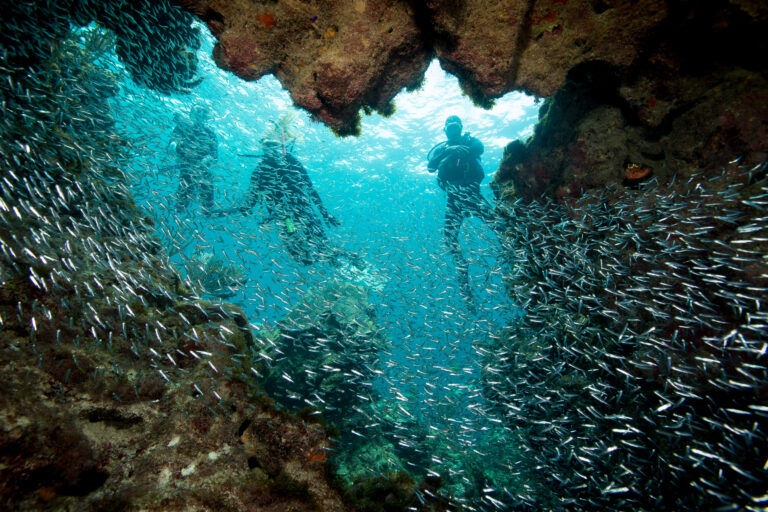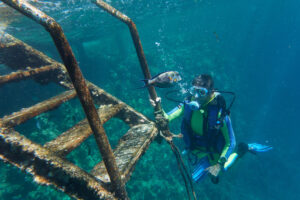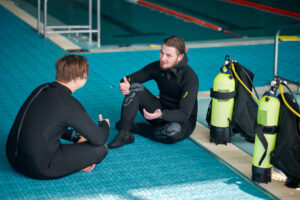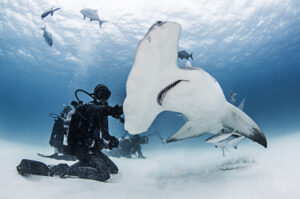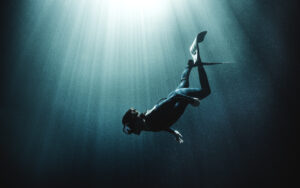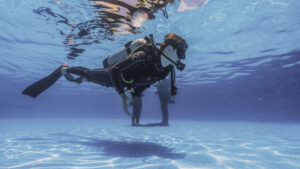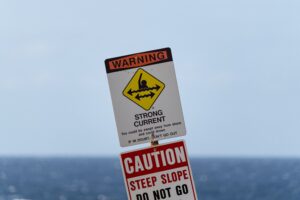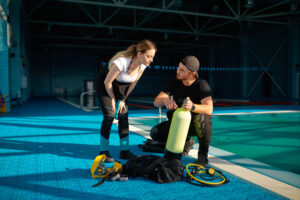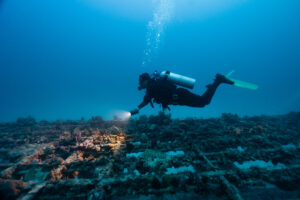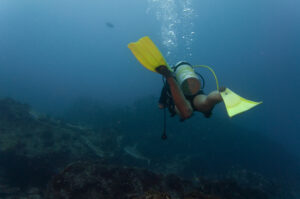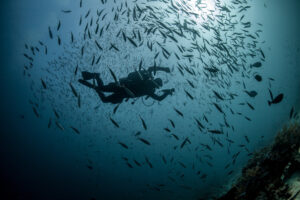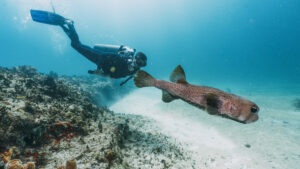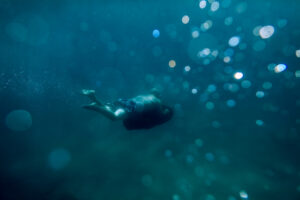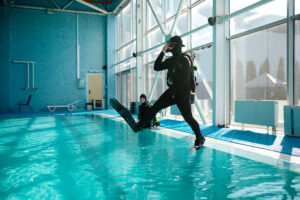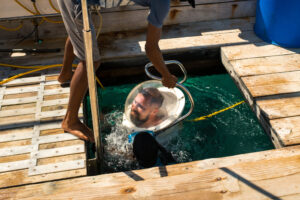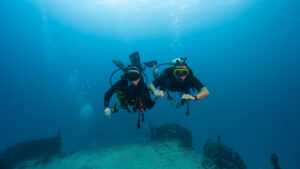What is Cavern Diving?
Cavern diving is a distinct form of scuba diving that involves exploring natural underwater caverns, allowing divers to experience the beauty and mystery of submerged cave systems. Unlike cave diving, where divers venture deep into the labyrinthine recesses of underwater cave networks, cavern diving stays within the sunlit zone, offering a safer and more controlled environment. Cavern divers do not stray far from the surface, ensuring they remain within a short distance of an emergency exit point. This sport attracts those fascinated by unique underwater formations, offering an adventurous alternative to traditional open-water diving.
The primary difference between cavern diving and cave diving is the level of accessibility and exposure to natural light. Cavern divers remain close to the cave entrance and are always within sight of natural sunlight. This zone, referred to as the “light zone,” provides a reassuring connection to the surface and reduces the risks associated with diving in completely dark, enclosed spaces. As a result, cavern diving is generally considered a safer option for those interested in underwater exploration without the need for extensive cave-diving qualifications.
Despite its relative accessibility, cavern diving still requires specialized skills, training, and equipment. Though the risks are lower than those faced by cave divers, the cavern environment presents unique challenges that divers must be prepared for. Cavern diving provides a glimpse into a world few get to see, offering the beauty of submerged geological formations, stalactites, and sometimes even hidden marine life, all while remaining tethered to the surface by sunlight and safety.
The Basics of Cavern Diving
Cavern diving is characterized by specific depth and distance limitations that distinguish it from more advanced types of diving. According to industry standards, cavern divers must not exceed a depth of 70 feet (21 meters) or venture more than 200 linear feet (60 meters) from the surface opening. These restrictions are crucial to ensure the diver remains within the safe, sunlit zone and has a straightforward path back to the surface. The importance of staying within this range cannot be overstated, as exceeding these limits brings additional hazards such as disorientation and difficulties with emergency ascent.
Another important aspect of cavern diving is the visibility of natural sunlight. The fact that light from the surface permeates the cavern means that divers are always aware of their proximity to an exit. This not only adds to the visual appeal of the environment but also acts as a critical safety measure. As long as divers stay within the area illuminated by sunlight, they retain a clear visual reference to the entrance, reducing the chances of becoming disoriented or lost.
Though the physical parameters of cavern diving make it relatively safe, it is still essential to be mindful of the potential risks. Divers must have the necessary training and a solid understanding of the unique aspects of cavern environments. While the sunlit zone may be less risky than deeper cave systems, it is still an overhead environment, meaning there is no direct access to the surface in case of an emergency. Therefore, cavern diving combines the excitement of underwater exploration with a constant need for situational awareness and preparation.
Safety and Training
Cavern diving, though more accessible than cave diving, requires thorough preparation and specialized training to ensure safety. Even though the risks are reduced compared to deeper cave systems, divers still face potential hazards, including poor visibility, entrapment, and equipment failure. To mitigate these risks, aspiring cavern divers must seek out certification programs from recognized diving organizations such as the Professional Association of Diving Instructors (PADI) or Scuba Schools International (SSI). These courses provide comprehensive training in navigation, buoyancy control, and emergency procedures specific to the cavern environment.
Training programs for cavern diving emphasize the development of technical skills that differ from those required for open-water diving. For example, divers must learn to navigate using lines and reels, maintain excellent buoyancy control to avoid disturbing sediments, and respond to emergencies in an overhead environment. These programs also focus on familiarizing divers with the specialized equipment necessary for cavern diving, such as primary and backup dive lights and dive computers. Additionally, divers are trained to recognize and respect the natural limitations imposed by the cavern environment, ensuring that they remain within safe operational parameters at all times.
An important aspect of cavern diving training is the emphasis on teamwork and communication. Cavern divers often work in pairs or small groups, with clear lines of communication and shared responsibilities for navigation and safety. This collaborative approach is crucial, as any emergency in a cavern can have serious consequences if not handled swiftly and efficiently. By completing a certified training program, divers can gain the confidence and skills necessary to safely explore cavern environments while minimizing the inherent risks of this thrilling underwater activity.
Equipment
Cavern diving requires not only standard scuba gear but also additional, specialized equipment designed to address the unique challenges of the cavern environment. Beyond the basic mask, fins, and regulator, cavern divers rely on specific tools to navigate safely and handle potential risks associated with limited light, restricted spaces, and depth variations.
Primary Dive Light
The primary dive light is an essential piece of equipment for cavern divers. It provides the necessary illumination to see clearly in the often dimly lit or dark areas of the cavern. Unlike open-water dives, where sunlight can penetrate to greater depths, the light from the surface may not be sufficient in a cavern, particularly as divers explore deeper into the space. A high-quality, waterproof dive light ensures that divers can see their surroundings, read instruments, and communicate with their dive partners using light signals. The primary light also enhances the experience by highlighting the stunning underwater features of the cavern.
Backup Dive Light
In cavern diving, redundancy is key to safety, and a backup dive light is a critical component of the diver’s equipment. Should the primary light fail during the dive, the backup light provides an immediate alternative, ensuring the diver can continue to navigate and find their way back to the entrance. A malfunctioning light source in an overhead environment can lead to dangerous disorientation, so having a reliable backup is non-negotiable. These lights are typically smaller but still powerful enough to provide sufficient illumination for the duration of the dive.
Line and Reel
The line and reel are perhaps the most distinctive and symbolic pieces of cavern diving gear. Divers use these tools to lay a physical line from the entrance of the cavern, allowing them to retrace their steps if needed. The reel lets the diver deploy the line progressively as they move deeper into the cavern, and wind it back up when returning to the surface. This safety line is crucial because visibility can rapidly decrease due to stirred-up sediment, and a well-placed line acts as a reliable guide in conditions where navigation by sight becomes difficult.
Dive Computer
A dive computer is an indispensable tool for managing depth, dive time, and air consumption. In cavern diving, where conditions can vary, a dive computer helps divers monitor critical data in real time. The computer calculates safe ascent rates, decompression limits, and alerts divers when they are approaching critical thresholds. This device allows divers to plan and execute their dives with greater precision, reducing the risk of decompression sickness and ensuring that air reserves are carefully managed throughout the dive.
Surface Marker Buoy (SMB)
The Surface Marker Buoy (SMB) is a brightly colored inflatable device used to signal the diver’s position to those on the surface, including boats or safety personnel. It is tethered to the diver during their ascent and floats on the surface, marking their location. In an emergency, the SMB becomes a vital tool for summoning help, ensuring that surface observers are aware of the diver’s position and can respond promptly if necessary. It is an important safety measure, particularly when cavern diving in remote locations or areas with boat traffic.
Conservation and Environmental Awareness
Cavern diving provides a unique opportunity to observe and interact with some of the most fragile and beautiful ecosystems on the planet. However, these environments are highly sensitive to human activity, and divers must be aware of the potential impact they can have on the underwater world. Strict conservation guidelines are in place to protect the delicate formations found within caverns, such as stalactites and stalagmites, which have taken thousands of years to form.
One of the primary concerns in cavern diving is the risk of physical damage to the environment. Even a slight touch can break or erode fragile formations, leading to irreversible harm. Divers are trained to avoid direct contact with cavern walls and formations, maintaining a safe distance to prevent accidental damage. Additionally, divers must be mindful of their equipment, particularly fins, which can disturb the sediment on the cavern floor. Stirring up sediment can lead to reduced visibility, not only for the diver but also for any marine life that inhabits the area.
Conservation efforts also focus on protecting the aquatic life that resides in caverns. Cavern environments are often home to unique species of fish, crustaceans, and other marine organisms that have adapted to the specific conditions of the underwater ecosystem. Divers must take care not to disturb these creatures or their habitats, avoiding actions that could alter the delicate balance of the ecosystem. By adhering to responsible diving practices and respecting conservation guidelines, divers can ensure that these underwater sanctuaries remain intact for future generations to appreciate.
Key Takeaways
Cavern diving offers a fascinating and accessible way for divers to experience the underwater world’s hidden wonders while maintaining a close connection to the safety of the surface. Through proper training, specialized equipment, and a commitment to conservation, divers can explore these unique environments safely and responsibly. Cavern diving not only enhances a diver’s technical skills but also deepens their understanding of the fragile ecosystems that exist within these underwater caverns, providing an experience that is as educational as it is thrilling.

